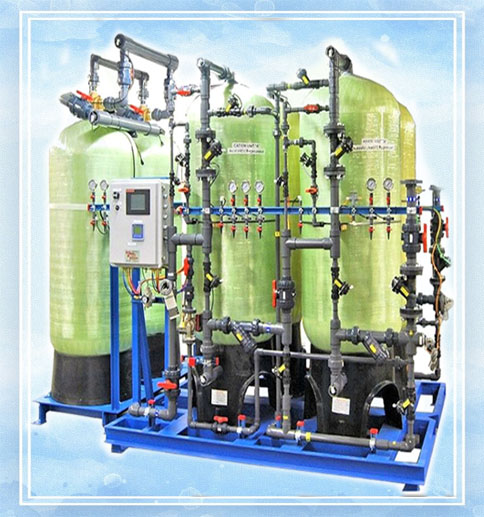INDUSTRIAL SEPARATE BED DEIONIZER
De-ionization is the removal or reduction of positive ions called cations and negative ions called anions from the water supply.
Industrial Separate Bed Deionizer
Deionization is the removal or reduction of positive ions called cations and negative ions called anions from the water supply. High purity water from 50 to 1 micro Siemens/cm can be produced from typical water sources. The cation resin is converted to the hydrogen form and exchanges positive ions for hydrogen. The anion resin is converted to the hydroxyl form and exchanges the negative ions for hydroxyl. This natural process removes the majority of the dissolved minerals and produces deionized water (H2O). Separate bed systems utilize one vessel for the cation regeneration and one vessel for the anion regeneration process, and therefore the resins are regenerated in situ. This natural process doesn’t reduce the bacterial count of the water if present. Sediment strainers are standard equipment on the cation and anion outlet and drain piping, and act as resin traps. Standard FDI systems are skid mounted with interconnecting piping and isolation valves. Composite Pressure Vessels are constructed of Industrial grade fiberglass with a polyethylene inner shell. The vessels provide outstanding durability and high corrosion resistance and weigh about one-third less than steel tanks. ASME code-certified vessels are available in sizes over 18inches. Composite vessels are rated 150 PSI maximum working pressure. RESINS are designed specifically for deionizer applications and are typically regenerated with 6 lbs. of 100% HCI per Cubic foot of cation resin and 8 lbs. of 100% NaOH per cubic foot of anion resin. Lakesideresins provide high chemical and physical stability, lower pressure drop, and greater resistance to bead breakage. Resins are selected based on the customers’ water quality requirements. Strong Base Type I or II Anion resin is selected based upon the silica residuals required for the precise application. Chemical Educators are constructed of PVC, and in combination with throttling valves, deliver the right concentration of chemical to the resin. Standard systems utilize pressure compensating educators for drawing chemicals from chemical carboys or drums. A throttling valve is provided to lower the concentration to five HCl and 4% NaOH for D.I. regeneration.
Features & Benefits:
Heavy-gauge steel pressure vessels are internally lined with a chemically resistant vinyl-ester coating. All exterior surfaces are coated with an acid and caustic-resistant “Safety Blue” paint finish. Non-ASME construction with 100 PSIG working pressure.
Flat-false bottom resin support with a hub-radial, non-clogging underdrain constructed of PVC for the last word in corrosion resistance.
High capacity, strong-acid cation exchange resin in the hydrogen form.
High capacity, Type 2 strong-base anion exchange resin in hydroxide-from (shipped in chloride form).
Sch 80 PVC face-piping assemblies with thermo-plastic, normally-open, “Y” pattern diaphragm control valves. Vessels with service piping 4″ and bigger utilize Sch 80 PVC face-piping and double-acting butterfly control valves. All control valves are air-operated requiring an 80-100 psi of unpolluted, plant air supply.
Cation and anion vessels are mounted on a structural steel skid and pre-piped to the fullest extent for minimal floor space requirements and simple installation.
Comprehensive Programmable Logic Controller (PLC) system pre-wired during a NEMA-4X electrical enclosure. Includes all operator switches, pushbuttons, indicator/alarm lights, and heavy-duty solenoids for control valve actuation.
Panel-mounted system flow meter and DI water conductivity monitor with an alphanumeric display.
Pre-assembled system pressure gauge and sampling valve center.

